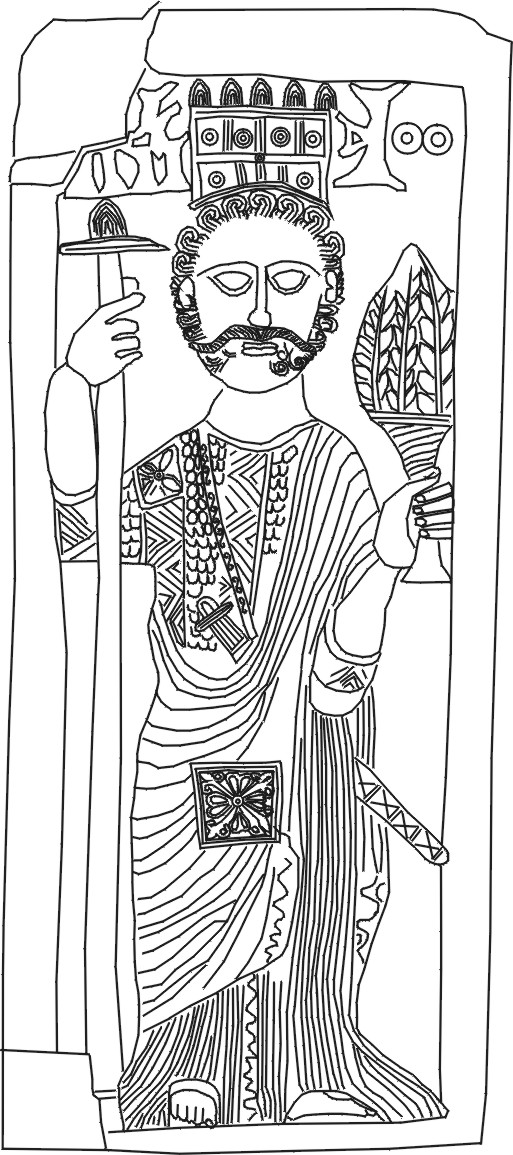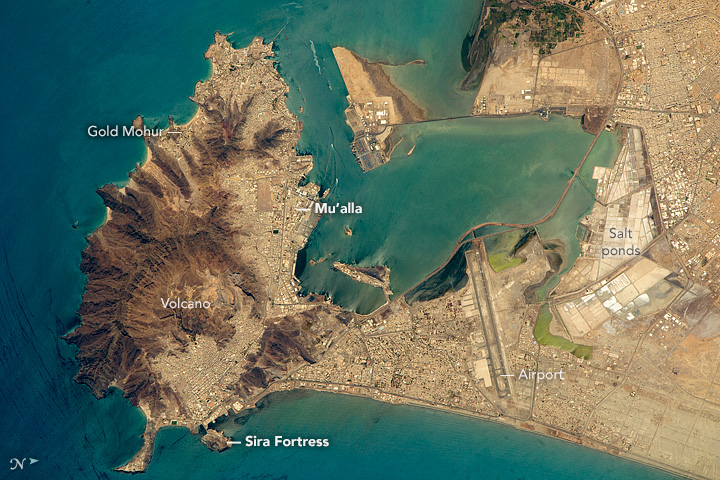|
Charibael
Charibael ( Sabaean: ''Karibʾīl'', "Blessed by God", or "Following God") was a South Arabian ruler described in and contemporary with the 1st-centuryAD ''Periplus of the Erythraean Sea''. Name The two Greek manuscripts of the ''Periplus'' give the names grc-gre, Χαριβαήλ, ''Kharibaḗl'', or , ''Kharibaḗla'', Latinized as ''Charibael'' or ''Charibaël''. There is now widespread agreement that the name represents a transcription of the Sabaean name ( Sabaean:). Pace Glaser & Schoff, this was not a title but was a regnal name shared by numerous other South Arabian rulers. Description The ''Periplus'' calls Charibael the "lawful king" of the "Homerites" and "those living next to them called the Sabaites".. He is said to dwell in Saphar and to maintain friendship with the Roman emperors by means of "continual embassies and gifts". He is said to exercise control over the towns of "Muza". ( Mocha). and "Saua" (Taiz). in "Mapharitis" through a "vassal-chief" named "C ... [...More Info...] [...Related Items...] OR: [Wikipedia] [Google] [Baidu] |
Periplus Of The Erythraean Sea
The ''Periplus of the Erythraean Sea'' ( grc, Περίπλους τῆς Ἐρυθρᾶς Θαλάσσης, ', modern Greek '), also known by its Latin name as the , is a Greco-Roman periplus written in Koine Greek that describes navigation and trading opportunities from Roman Egyptian ports like Berenice Troglodytica along the coast of the Red Sea, and others along Horn of Africa, the Persian Gulf, Arabian Sea and the Indian Ocean, including the modern-day Sindh region of Pakistan and southwestern regions of India. The text has been ascribed to different dates between the first and third centuries, but a mid-first-century date is now the most commonly accepted. While the author is unknown, it is clearly a first-hand description by someone familiar with the area and is nearly unique in providing accurate insights into what the ancient Hellenic world knew about the lands around the Indian Ocean. Name A periplus ( grc-gre, περίπλους, ''períplous'', ."a sailing-around ... [...More Info...] [...Related Items...] OR: [Wikipedia] [Google] [Baidu] |
Crowned Man, Zafar
Crowned may refer to: * Senses of "to crown": ** Having been the object of a coronation A coronation is the act of placement or bestowal of a coronation crown, crown upon a monarch's head. The term also generally refers not only to the physical crowning but to the whole ceremony wherein the act of crowning occurs, along with the ... ** Crowning stage of childbirth * Titled works: ** ''Crowned'' (web series), an American comedy web series ** '' Crowned: The Mother of All Pageants'', an American TV series See also * Crown (other) {{disambiguation ... [...More Info...] [...Related Items...] OR: [Wikipedia] [Google] [Baidu] |
Taiz
Taiz ( ar, تَعِزّ, Taʿizz) is a city in southwestern Yemen. It is located in the Yemeni Highlands, near the port city of Mocha, Yemen, Mocha on the Red Sea, at an elevation of about above sea level. It is the capital of Taiz Governorate. With a population of over 600,000 in 2005, it is the largest city in Yemen in terms of population ahead of the capital Sana'a and the southern port city of Aden. Due to the Taiz campaign (2015–present), ongoing campaign as part of Yemeni Civil War (2015–present), Yemen's civil war, Taiz is a battleground and a war zone. Once known as the "cultural capital of Yemen", the war has bestowed a new title, "city of snipers". History The 14th century traveller Ibn Battuta visited Taiz: We went on ... to the town of Taʻizz, the capital of the king of Yemen, and one of the finest and largest towns in that country. Its people are overbearing, insolent, and rude, as is generally the case in towns where kings reside. Taʻizz is made up of thre ... [...More Info...] [...Related Items...] OR: [Wikipedia] [Google] [Baidu] |
Gallus Expedition
The Roman presence in the Arabian Peninsula had its foundations in the expansion of the empire under Augustus, and continued until the Arab conquests of Eastern Roman territory from the 620s onward. Initial contacts The volume of commerce between Rome and India via Red Sea and Arabian Sea was huge since the conquest of Egypt by the Romans in 30 BC, according to the historian Strabo: 120 Roman vessels sailed every year from Berenice Troglodytica and many times touched southern Arabia Felix on their travel to India, while doing the Spice Route. Mostly in order to secure the maritime route from piracy, the Romans organized an expedition under Aelius Gallus in which the port of Aden (then called Eudaemon) in southern Arabia was occupied temporarily. The Romans furthermore maintained a small legionary garrison in the Nabataean port of Leuke Kome ("meaning "the white village", located north of the Arabian port of Jeddah) in the 1st century in order to control the commerce of spices, ... [...More Info...] [...Related Items...] OR: [Wikipedia] [Google] [Baidu] |
Eleazus
Eleazus, also Eleazar or Iliazz Yalit I was the Hadramaut king of the southern tip of the Arabian peninsula, the "Frankincense kingdom", in the 1st century CE. The main harbour of the kingdom was Cana (Kanê). His capital was the city of Sabat. It is thought that Khor Rawri, anciently the biblical port of Sumhuram, was founded by King Eleazus. Eleazus is described in the Periplus of the Erythraean Sea: See also *List of rulers of Saba and Himyar This is a list of rulers of Saba and Himyar. Mukarrib (Mukrab, Karab), a religious title that means "near to God", was used by rulers of Saba' until Karib'il Watar changed his title to ''Malik'' at the time of the kingdom of Saba' and Dhu Rayda ... History of Yemen 1st-century Arabs 1st-century Yemeni people {{Yemen-stub ... [...More Info...] [...Related Items...] OR: [Wikipedia] [Google] [Baidu] |
Heinrich Theodor Dittrich
Heinrich Theodor Dittrich ( la, Henricus Theodorus Dittricus;. -19th century) was a German philologist and librarian.. Works Under the pseudonym , he published a Latin edition on the surviving Greek fragments of the ''Periplus of the Outer Sea'' (i.e., the World Ocean) and epitomes composed by Marcian and the ''Periegesis'' or '' Periodos'' misattributed to Scymnus; an overview of his thoughts on the Greek bucolic poet Theocritus and on the lesser Greek geographers; heavily annotated Latin and German translations of the Greek ''Periplus of the Erythraean Sea'' (i.e., the Red Sea and Indian Ocean) misattributed to Arrian; a Latin translation of Isidore's Greek ''Parthian Stations''; a heavily annotated Latin translation of the Greek '' Periplus of the Internal Seas'' (i.e., the Mediterranean and Black Seas) misattributed to Scylax; and a heavily annotated edition of the Latin elegies of Albius Tibullus Albius Tibullus ( BC19 BC) was a Latin poet and writer of elegies. His fi ... [...More Info...] [...Related Items...] OR: [Wikipedia] [Google] [Baidu] |
Karl Wilhelm Ludwig Müller
Karl Wilhelm Ludwig Müller ( la, Carolus Müllerus; 13 February 1813 in Clausthal – 1894 in Göttingen) is best known for his still-useful Didot editions of fragmentary Greek authors, especially the monumental five-volume ''Fragmenta Historicorum Graecorum'' (''FHG'') (1841–1870), which is not yet completely superseded by the series ''Die Fragmente der griechischen Historiker'' begun by Felix Jacoby. Works * ''De Aeschyli Septem Contra Thebas'', Diss. Göttingen (1836)online* ''Fragmenta Historicorum Graecorum'' (1841–1870): vols1 [...More Info...] [...Related Items...] OR: [Wikipedia] [Google] [Baidu] |
Aden
Aden ( ar, عدن ' Yemeni: ) is a city, and since 2015, the temporary capital of Yemen, near the eastern approach to the Red Sea (the Gulf of Aden), some east of the strait Bab-el-Mandeb. Its population is approximately 800,000 people. Aden's natural harbour lies in the crater of a dormant volcano, which now forms a peninsula joined to the mainland by a low isthmus. This harbour, Front Bay, was first used by the ancient Kingdom of Awsan between the 7th to 5th centuries BC. The modern harbour is on the other side of the peninsula. Aden gets its name from the Gulf of Aden. Aden consists of a number of distinct sub-centres: Crater, the original port city; Ma'alla, the modern port; Tawahi, known as "Steamer Point" in the colonial period; and the resorts of Gold Mohur. Khormaksar, on the isthmus that connects Aden proper with the mainland, includes the city's diplomatic missions, the main offices of Aden University, and Aden International Airport (the former British Roy ... [...More Info...] [...Related Items...] OR: [Wikipedia] [Google] [Baidu] |
Somalia
Somalia, , Osmanya script: 𐒈𐒝𐒑𐒛𐒐𐒘𐒕𐒖; ar, الصومال, aṣ-Ṣūmāl officially the Federal Republic of SomaliaThe ''Federal Republic of Somalia'' is the country's name per Article 1 of thProvisional Constitution, (; ), is a country in the Horn of Africa. The country is bordered by Ethiopia to the west, Djibouti to the northwest, the Gulf of Aden to the north, the Indian Ocean to the east, and Kenya to the southwest. Somalia has the longest coastline on Africa's mainland. Its terrain consists mainly of plateaus, plains, and highlands. Hot conditions prevail year-round, with periodic monsoon winds and irregular rainfall. Somalia has an estimated population of around million, of which over 2 million live in the capital and largest city Mogadishu, and has been described as Africa's most culturally homogeneous country. Around 85% of its residents are ethnic Somalis, who have historically inhabited the country's north. Ethnic minorities are ... [...More Info...] [...Related Items...] OR: [Wikipedia] [Google] [Baidu] |
Azania
Azania ( grc, Ἀζανία) is a name that has been applied to various parts of southeastern tropical Africa. In the Roman period and perhaps earlier, the toponym referred to a portion of the Southeast Africa coast extending from northern Kenya to the border between Mozambique and South Africa. Azania was mostly inhabited by Southern Cushitic peoples, whose groups would rule the area until the great Bantu Migration. Ancient Azania Azania was a region in ancient Arcadia, which was according to Pausanias named after the mythical king Azan. According to Herodotus, the region contained the ancient town of Paus. The use of this name coincides with a reference in which Pliny the Elder mentions an "Azanian Sea" (N.H. 6.34) that began around the emporium of Adulis and stretched around the south coast of Africa. It may well be that the Greek usage resonated with a term already in use around the Horn of Africa especially in the light of the fact that the term with a different meaning to ... [...More Info...] [...Related Items...] OR: [Wikipedia] [Google] [Baidu] |
Oman
Oman ( ; ar, عُمَان ' ), officially the Sultanate of Oman ( ar, سلْطنةُ عُمان ), is an Arabian country located in southwestern Asia. It is situated on the southeastern coast of the Arabian Peninsula, and spans the mouth of the Persian Gulf. Oman shares land borders with Saudi Arabia, the United Arab Emirates, and Yemen, while sharing Maritime boundary, maritime borders with Iran and Pakistan. The coast is formed by the Arabian Sea on the southeast, and the Gulf of Oman on the northeast. The Madha and Musandam Governorate, Musandam exclaves are surrounded by the United Arab Emirates on their land borders, with the Strait of Hormuz (which it shares with Iran) and the Gulf of Oman forming Musandam's coastal boundaries. Muscat is the nation's capital and largest city. From the 17th century, the Omani Sultanate was Omani Empire, an empire, vying with the Portuguese Empire, Portuguese and British Empire, British empires for influence in the Persian Gulf and Indian ... [...More Info...] [...Related Items...] OR: [Wikipedia] [Google] [Baidu] |



